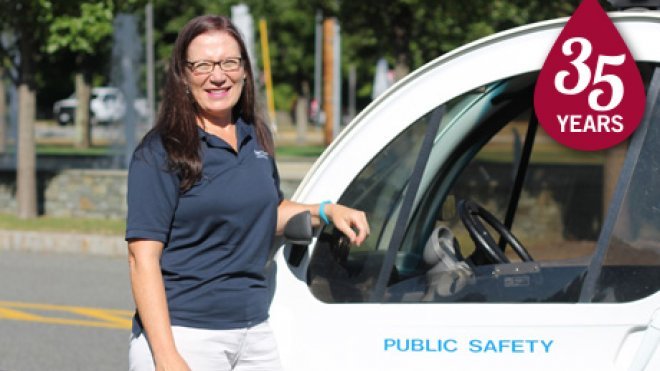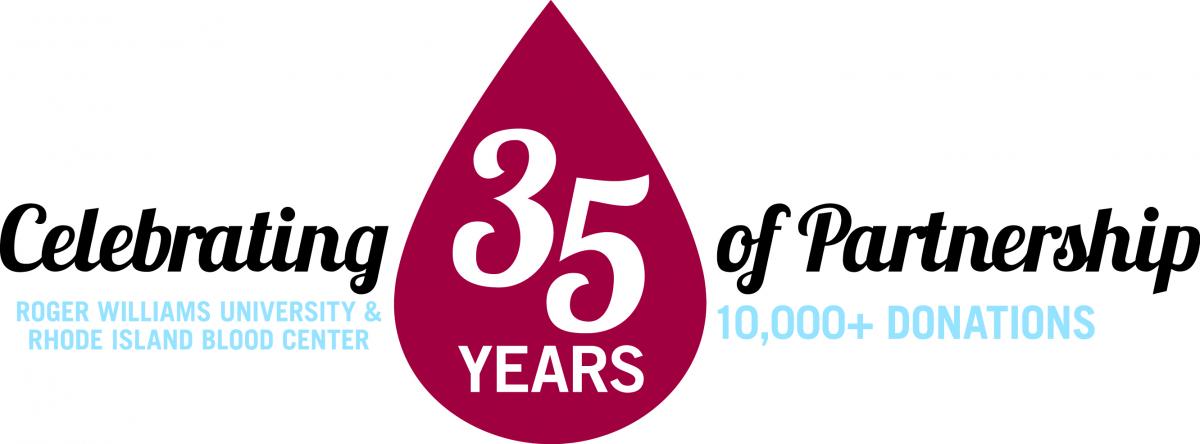Blood Donation: It’s Just the Ticket
Assistant Manager of Transportation and Parking Kate Tobin on the benefits of blood donation, and why every pint counts

BRISTOL, R.I. – One pint. Three lives.
It’s a simple equation, says Kate Tobin, assistant manager of transportation and parking at RWU. That’s how many lives you will save with a single donation to your local blood bank.
As the first blood drive of the academic year kicks off at Roger Williams on October 7, Tobin is about to make her 97th donation. By that calculation, Tobin is on the verge of having saved 291 strangers. All in 30 minutes’ work (every eight weeks, for 37 years), she says.
“Why wouldn’t you give if you can?” Tobin asks. “You’re saving three lives, you have the opportunity to make a difference in someone’s life.”
Tobin became a blood donor at age 18 when her father belonged to the Knights of Columbus. As a family, they would head to the blood drive and stay for the steak and eggs after their donation was complete. She continued the tradition with her husband, Bob, and their two daughters. For years they would go to the blood center together in Middletown, R.I., on Saturdays. When her longtime employer, Raytheon, began offering workplace blood drives, Tobin began attending those for added convenience. Now at Roger Williams for 15 years, she has donated at every RWU blood drive since her start date.
“It’s free, it’s easy, it’s fast. And here at work, it’s so convenient. You’re giving a part of yourself – and you lose a pound!” she notes as an added incentive for the hesitant.
There are many fond memories, she says, including learning that she had reached the 1 gallon milestone (to date she’s donated 12 gallons) and watching her brother-in-law go face down into a plate of steak and eggs after a donation. But perhaps the most moving was a phone call from the Rhode Island Blood Center about a month after the 9/11 terrorist attacks. She and Bob had made their regular donation on Saturday, Sept. 8, and their blood had been sent to help victims in New York.
Both Tobin and her husband have A-negative blood, making it especially valuable both in daily situations and extraordinary circumstances, like 9/11. According to the American Red Cross, a mere 7 percent of Caucasians have A-negative blood, while only 2 percent of African Americans, 2 percent of Hispanics and less than 1 percent of Asians carry that blood type. With low supply sources, Tobin’s blood type is in high demand on a regular basis. And, she notes, a number of blood supplies have been cut off through the years for reasons ranging from mad cow disease to tick borne diseases and a host of others in between.
“There are so many people who want to give, but who can’t,” Tobin says. “So it’s important that others, those who can, do.”
And the Tobins’ donations haven’t just saved countless lives – their own health has been preserved in the process. Following her second pregnancy, Tobin was alerted of an anomaly in her blood type that limits which blood types she can receive should she require a blood transfusion. And, after decades of donating blood, it was a call from the Rhode Island Blood Center that alerted Bob Tobin that he had Babeseosis – a tick-borne disease akin to Malaria. He could no longer donate.
“He was very hurt – devastated,” Tobin says. “But there’s a reason they test all of the blood. It’s fascinating, and I’m very thankful.”
In the days leading up to the October blood drive, Tobin will be manning registration tables in the Upper Commons,  encouraging students and community members to open up their arms to the friendly phlebotomists who will stationed in the North Residence Hall for two days of donations. And, she says, she’ll be first in line (as always) to make her donation.
encouraging students and community members to open up their arms to the friendly phlebotomists who will stationed in the North Residence Hall for two days of donations. And, she says, she’ll be first in line (as always) to make her donation.
“I just think this is so exciting to be celebrating the 35th anniversary of the Roger Williams and RIBC partnership. I love the fact that we’re donation site 0001 – it’s amazing to be part of that.”
For more information, or to register for the October blood drives, visit https://www.ribcdonor.org. Walk-ins are welcome, and the community is invited to an honorary ribbon cutting and reception on Oct. 7 at 10:30 a.m. at the North Residence Hall First Floor Lounge.